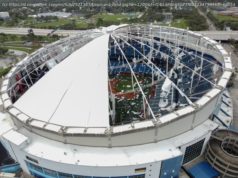AMSTERDAM (AP) — Standing between raised beds of plants on top of a former naval hospital, Joris Voeten can look across to…
AMSTERDAM (AP) — Standing between raised beds of plants on top of a former naval hospital, Joris Voeten can look across to the garden, cafe and terrace that decorate the sloping roof of Amsterdam’s NEMO science museum.
Such productivity is part of the urban engineer’s vision for cities worldwide, places where he sees the largely neglected flat tops of buildings doing more than keeping out weather and housing satellite dishes.
Voeten, of Dutch company Urban Roofscapes, says a rooftop garden system he unveiled Friday on the former hospital roof stores more rainwater than existing green roofs and requires less power by relying on a capillary irrigation system that uses insulation material instead of pumps to water plants.
« You can relax here, you can have meetings here. You could operate a restaurant on your rooftop garden to make it more economically beneficial, » Voeten told The Associated Press ahead of the official presentation. « But most of all, we finally get to exploit the last unused square meterage in the urban environment. »
Roofs that are adapted so plants can grow on them produce a cooling effect on buildings and the air immediately above them in two ways. The plants reflect heat instead of absorbing it the way traditional roofing sheets do. They also reduce heat by evaporating water.
Voeten said readings taken on a very hot day showed a temperature difference of up to 40 degrees Celsius (72 degrees Fahrenheit) between his hospital garden above the banks of a busy waterway compared with a roof covered in black bitumen.
Robbert Snep, a green roof expert from Wageningen University and Research in the central Netherlands, said the cooling effect is well known, but the new roof in Amsterdam is an improvement on existing designs because of the way it stores water and can feed it back to plants.
Sensors in the shallow layer of soil on top of the water storage elements monitor qualities such as temperature and moisture content. If the soil gets too dry, extra water can be added. If there is too much water, it can be released into the drains.
« The smart roof really ensures that there is evaporation during, for example, heatwaves and thereby they cool the surroundings, » Snep, who is not involved in the project, said. « People can sleep well and people can work well in such an environment. »
Voeten says his system can be laid on any flat roof with sufficient load-bearing capacity, Voeten said. Costs would likely be around 100-150 euros ($120-180) per square meter (10 square feet) , he estimates.
Amsterdam, a city built around water and its World Heritage-listed canals, is keen to have its residents turn their rooftops into gardens where possible. To promote the practice, the city is offers subsidies to help meet the costs.
« We ask citizens of the city to create rooftops like this. We ask companies to create rooftops like this, » Vice Mayor Eric van der Burg said. « Not only for water storage, not only for helping cooling down our city, but also to create extra gardens, extra green for our inhabitants. »






